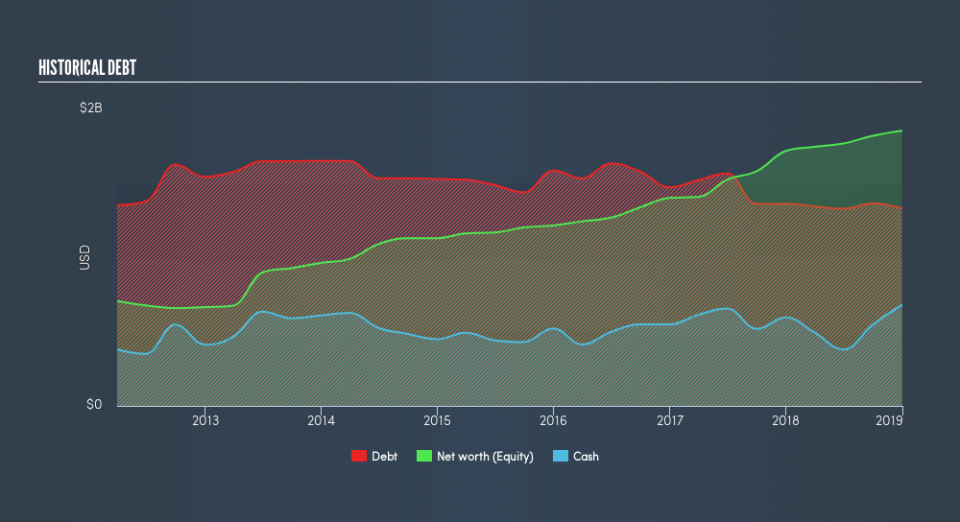Does Amkor Technology, Inc.’s (NASDAQ:AMKR) Debt Level Pose A Problem?

Stocks with market capitalization between $2B and $10B, such as Amkor Technology, Inc. (NASDAQ:AMKR) with a size of US$2.1b, do not attract as much attention from the investing community as do the small-caps and large-caps. Despite this, the two other categories have lagged behind the risk-adjusted returns of commonly ignored mid-cap stocks. AMKR’s financial liquidity and debt position will be analysed in this article, to get an idea of whether the company can fund opportunities for strategic growth and maintain strength through economic downturns. Note that this commentary is very high-level and solely focused on financial health, so I suggest you dig deeper yourself into AMKR here.
View our latest analysis for Amkor Technology
Does AMKR produce enough cash relative to debt?
AMKR has sustained its debt level by about US$1.3b over the last 12 months including long-term debt. At this current level of debt, the current cash and short-term investment levels stands at US$682m , ready to deploy into the business. Additionally, AMKR has produced US$663m in operating cash flow during the same period of time, resulting in an operating cash to total debt ratio of 50%, signalling that AMKR’s current level of operating cash is high enough to cover debt. This ratio can also be interpreted as a measure of efficiency as an alternative to return on assets. In AMKR’s case, it is able to generate 0.5x cash from its debt capital.
Can AMKR meet its short-term obligations with the cash in hand?
Looking at AMKR’s US$1.2b in current liabilities, the company has been able to meet these commitments with a current assets level of US$1.7b, leading to a 1.44x current account ratio. Generally, for Semiconductor companies, this is a reasonable ratio as there’s enough of a cash buffer without holding too much capital in low return investments.
Is AMKR’s debt level acceptable?
AMKR is a relatively highly levered company with a debt-to-equity of 72%. This is not unusual for mid-caps as debt tends to be a cheaper and faster source of funding for some businesses. No matter how high the company’s debt, if it can easily cover the interest payments, it’s considered to be efficient with its use of excess leverage. A company generating earnings after interest and tax at least three times its net interest payments is considered financially sound. In AMKR’s case, the ratio of 3.48x suggests that interest is appropriately covered, which means that debtors may be willing to loan the company more money, giving AMKR ample headroom to grow its debt facilities.
Next Steps:
Although AMKR’s debt level is towards the higher end of the spectrum, its cash flow coverage seems adequate to meet obligations which means its debt is being efficiently utilised. This may mean this is an optimal capital structure for the business, given that it is also meeting its short-term commitment. This is only a rough assessment of financial health, and I’m sure AMKR has company-specific issues impacting its capital structure decisions. I recommend you continue to research Amkor Technology to get a better picture of the mid-cap by looking at:
Future Outlook: What are well-informed industry analysts predicting for AMKR’s future growth? Take a look at our free research report of analyst consensus for AMKR’s outlook.
Valuation: What is AMKR worth today? Is the stock undervalued, even when its growth outlook is factored into its intrinsic value? The intrinsic value infographic in our free research report helps visualize whether AMKR is currently mispriced by the market.
Other High-Performing Stocks: Are there other stocks that provide better prospects with proven track records? Explore our free list of these great stocks here.
We aim to bring you long-term focused research analysis driven by fundamental data. Note that our analysis may not factor in the latest price-sensitive company announcements or qualitative material.
If you spot an error that warrants correction, please contact the editor at editorial-team@simplywallst.com. This article by Simply Wall St is general in nature. It does not constitute a recommendation to buy or sell any stock, and does not take account of your objectives, or your financial situation. Simply Wall St has no position in the stocks mentioned. Thank you for reading.

